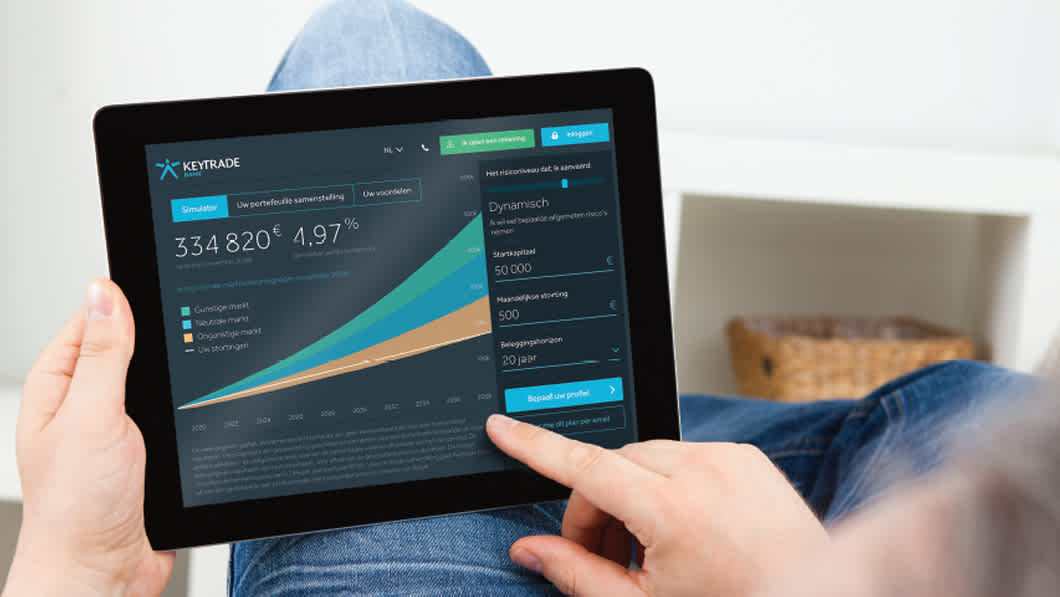How much diversification is enough for your portfolio?
Keytrade Bank
keytradebank.be
March 23, 2023
5 minutes to read
Diversification is one way to spread the inherent risk of investing. The reason you should be doing this is simple. If one of your shares, bonds, funds, trackers, etc. does badly, the better-performing ones can cancel it out. Broad diversification will also ensure your portfolio is less volatile (i.e. less of a rollercoaster).
Imagine you have a EUR 10,000 portfolio, with four different shares, and you have invested EUR 2,500 in each one. One then falls by 30%. As a result, the value of your portfolio drops from EUR 10,000 to EUR 9,250. Now imagine you have a portfolio worth EUR 10,000, with twenty different shares for EUR 500 each. And you invested in the same disastrous share that crashed 30%. In this case, the value of your portfolio will "only" fall to EUR 9,850.
Invest across sectors, topics and regions
Diversification is not just about the number of different shares or bonds in your securities account. To build up a diversified portfolio, it is equally important to invest in different sectors and areas. In other words, it is better to invest in twenty shares than in four. But if you invest everything in twenty airline shares, your portfolio will be just as vulnerable as before. A whole sector could take a severe dip depending on economic circumstances, monetary policy, geopolitical developments, stock market sentiment, etc. The same applies to including different regions. This is why it's better to invest in twenty shares than in four. It's better to invest in five sectors or investment themes than in one. And it’s better to invest in different regions than to restrict yourself to Belgian or European shares only.
Diversify across asset classes
Equities are just one way of investing. In addition, there are other asset classes such as bonds, commodities, gold, cash and real estate. Some asset classes, such as equities, are generally more risky and volatile than others, such as bonds. By investing your money in several different asset classes, you can spread the risks of your portfolio. You can also diversify further within each asset class. Not all shares are equally risky, and not all bonds are equally "safe". By investing in asset classes with different risk-return profiles, you can put together a portfolio that matches your investment goals and where you are in your life. For example, if you are young and have a high tolerance for risk, you can choose to invest more money in shares, while at a later age you may want to move more money into asset classes that involve lower risks. A common guideline is that the percentage of shares you hold should equal 120 minus your age. This means that if you follow this guideline and you are 35 years old you would hold 85% of your portfolio in shares.
Spreading over time
While markets historically show a long-term upward trend, it's impossible to predict exactly what they will do in the short term. By also spreading your investments over time, you reduce the impact of market fluctuations. To smooth out these fluctuations, it can be a good idea not to invest all your available assets at once, but to invest a little each month, quarter or year, for example. An easy way to do this is by investing regularly using an automatic standing order.
How much is enough diversification?
There is no magic formula, but as a general rule, no single investment should account for more than 3 to 5% of your portfolio. This means that as an absolute minimum, you will have 20 to 30 items in your portfolio. If you spread your assets less than this, you need to be very sure of what you're doing. This may be anecdotal, but in 2013 Warren Buffett stated that during his life he invested in 400 to 500 shares and that he got the most yield out of just 10 shares. His right-hand man Charlie Munger added: “If you took our top fifteen decisions out, we’d have a pretty average record.” So 20 or 30 different investments may be enough for a dynamic investor who is willing to take much higher risks in order to achieve a return. However, investors with a more cautious or defensive profile (most investors) are better advised to diversify much more.
Note that this 3% rule applies to individual securities such as shares and bonds, and does not apply to investment funds and trackers, as these already consist of hundreds or even thousands of investments. By investing in a number of balanced funds and/or trackers (each investing in different sectors, areas, regions and asset classes), you can build up a much better portfolio spread than by investing in fifty separate shares and bonds.
Over-diversification: is it possible?
Putting all your eggs in one basket is not a good idea. But too much diversification can also be unwise. Over-diversification occurs when you spread your money over so many different investments that you reduce your potential return without significantly reducing your risk. In addition, too much diversification can make it difficult to keep track of your investments and result in you investing in things you don't understand. It can also lead to higher costs.
A common diversification mistake is to invest in overlapping assets. Suppose you invest in an S&P500 tracker. This means you can invest in 500 American shares in one fell swoop that account for around 80% of the market capitalisation of the American stock market. Now suppose you want to diversify regionally a bit. At first glance, a tracker that follows the MSCI World might seem like a smart idea. This allows you to invest in an index of more than 1,500 shares in 23 different markets at the same time. However, if you look a little deeper under the hood of this index, you will see that it includes a mighty 67% of US shares. Of the 500 shares in the S&P500, more than 480 are also represented in the MSCI World Index. That’s a lot of duplication.
Three interesting diversification techniques
- Regular investment in a handful of funds can be an effective way to diversify your investments. This is ideal for investors who have little interest or little time available for their investments and who also want to invest small amounts of money only.
- Those who want to personalise their portfolio more may be interested in a core-satellite strategy approach. Under this approach, one part of your assets is invested in the core (e.g. 75%) and the other part in the satellites (e.g. 25%). This strategy obviously requires more homework than simply buying a regular investment plan.
- The core of your portfolio The core is the foundation of your portfolio. It consists of a broad mix of investments and asset classes that align with your risk appetite. For most investors, the core represents the majority of their portfolio. For example, you can fill out the core of your portfolio with a few share trackers, giving you a spread across different sectors, areas and regions. You can add to this a few bond trackers that invest in different categories (government bonds, corporate bonds, investment grade bonds, high-yield bonds). You can then add other building blocks, such as a commodities tracker. Flexible balanced funds offer an alternative to trackers. These are funds that invest in a mix of shares, bonds, cash and/or other asset classes. The managers of these funds have the flexibility to change the allocation between asset classes depending on market and economic conditions. Depending on the fund’s investment objectives, the allocation between shares, bonds and cash can therefore vary, and the fund may have a more aggressive or defensive positioning.
- The satellites in your portfolio Satellites are generally more risky than the core and could therefore also generate a higher potential return. There are different types of satellites. They might be investments in areas affected by megatrends (such as investments in elements related to the energy transition,water or rising health costs). They may also be investments that take advantage of a (temporary) market opportunity, such as the current higher returns in the bond sector. Finally, you can also add individual shares or bonds to your satellites.
- If you want to invest more than EUR 15,000, asset management could be an attractive option. A team of professionals will then manage a portfolio for you, in line with your risk appetite and market and economic trends.

